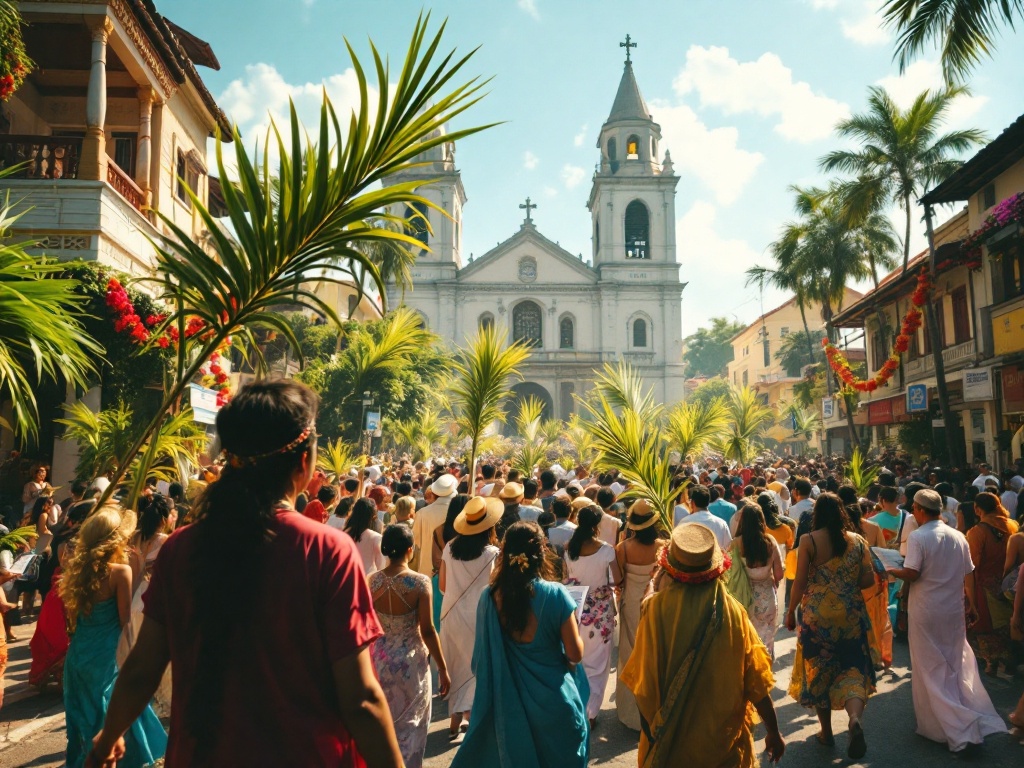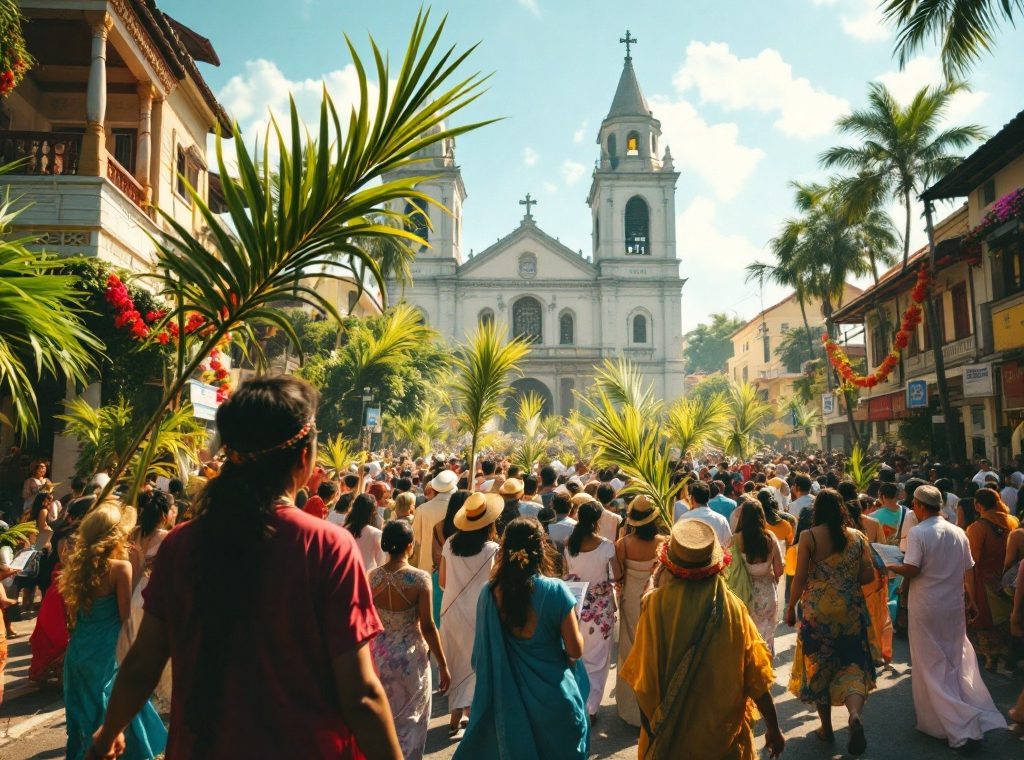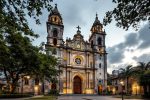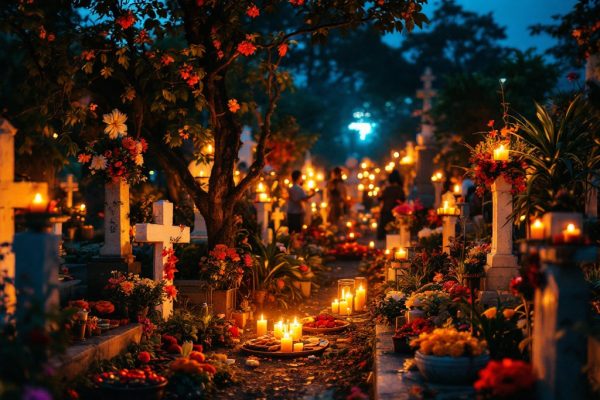Holy Week in the Philippines: Traditions and Celebrations
Experience the vibrant tapestry of faith and tradition in the Philippines during Holy Week. From Palm Sunday’s procession of *palaspás* to Easter Sunday’s joyous *Salubong*, witness unique rituals like the *Pabasa ng Pasyon*, *Visita Iglesia*, and dramatic *Senakulo* performances. Discover how Filipinos commemorate the Passion, Death, and Resurrection of Jesus Christ through solemn processions, quiet reflection, and celebratory feasts. Explore the rich cultural heritage of Holy Week in the Philippines and its profound spiritual impact on communities. Delve deeper into this sacred journey.
Important information

- Holy Week in the Philippines is a significant religious observance for Filipino Catholics, commemorating the Passion, Death, and Resurrection of Jesus Christ.
- Key traditions include processions like the Santo Entierro (depicting Christ’s burial), chanting the Pabasa ng Pasyon (recounting Christ’s life), Visita Iglesia (pilgrimage to seven churches), and dramatic reenactments of the Passion called the Senakulo.
- Unique rituals such as the Salubong (reenactment of the meeting between Jesus and Mary after the resurrection) and the Moriones Festival add to the rich cultural tapestry of Holy Week.
- The week is a time for both personal reflection and penance, with some Filipinos engaging in dramatic acts like self-flagellation while others opt for quieter forms of prayer and reflection.
- Holy Week fosters strong community bonds, bringing families and communities together for shared meals, religious services, and processions, reinforcing both faith and cultural values.
Holy Week in the Philippines: Traditions and Celebrations
Holy Week in the Philippines is a deeply significant time, especially for the Catholic majority. It commemorates the Passion, Death, and Resurrection of Jesus Christ, attracting tourists while remaining profoundly ingrained in Filipino culture. This week is rich with traditions, encompassing processions, church services, and unique rituals.
Unique Rituals during Holy Week
- Pabasa ng Pasyon, a chanting of Christ’s suffering.
- Visita Iglesia, a pilgrimage to seven churches.
- Senakulo, dramatic reenactments of Christ’s Passion.
Holy Week Observances
- Santo Entierro, a somber Good Friday procession.
- Siete Palabras, contemplation of Christ’s final words.
- Salubong, a joyful celebration of the resurrection.
Alay Lakad, a penitential walk, and the distinctive Moriones Festival of Marinduque are further Lenten observances. Along with fasting, Filipinos prepare special dishes for the occasion. Holy Week is a time for family, reflection, spiritual renewal, and community bonding.
Overview of Holy Week
Holy Week in the Philippines stretches from Palm Sunday to Easter Sunday, a time for families and friends to come together. This period commemorates Jesus’ passion and resurrection, highlighting the profound importance of faith in Filipino culture. It’s a deeply spiritual experience for many.
The Significance of Holy Week in Filipino Catholicism
For Filipino Catholics, Holy Week is a deeply meaningful time of reflection and penance, commemorating Jesus Christ’s Passion, Death, and Resurrection. These traditions reinforce both faith and cultural values. Observances include processions and religious services, alongside unique rituals like the Pabasa ng Pasyon, a chanted narration of Christ’s story, and the Visita Iglesia, a pilgrimage to seven churches.
The Start and End of Holy Week: Palm Sunday to Easter Sunday
Holy Week in the Philippines begins on Palm Sunday and ends on Easter Sunday. Palm Sunday commemorates Jesus’ triumphant entry into Jerusalem. Easter Sunday celebrates His resurrection. This week is a deeply spiritual journey for Filipino Catholics.
Traditional Observances and Rituals
Holy Week in the Philippines is a profoundly spiritual journey, deeply rooted in Catholic tradition. The week begins with Palm Sunday, where Filipinos flock to churches carrying palm fronds to symbolize Jesus’ triumphant entry into Jerusalem. These blessed tokens are then taken home as symbols of protection. Holy Wednesday often marks a pause in the work week, giving way to Tenebrae services and processions that usher in the Triduum. Maundy Thursday commemorates the Last Supper. Good Friday solemnly remembers Jesus’ crucifixion, often marked by poignant street plays and processions. The somber quiet of Black Saturday, a day of mourning, leads to the hopeful anticipation of the Easter Vigil. Finally, Easter Sunday erupts in joyous celebration of the resurrection. Throughout this sacred week, Filipinos gather for special masses and processions, reaffirming their strong spiritual bonds and community ties. It’s a time for both personal reflection and shared celebration.
Palm Sunday: Filipinos carry palm fronds to churches, symbolizing Jesus’ entry into Jerusalem. These are later taken home as symbols of protection.
Holy Wednesday: The work week often pauses for Tenebrae services and processions, ushering in the Triduum.
Maundy Thursday: This day commemorates the Last Supper.
Good Friday: This day solemnly remembers Jesus’ crucifixion, often with street plays and processions.
Black Saturday: A day of mourning and quiet anticipation for the Easter Vigil.
Easter Sunday: Joyous celebrations mark the resurrection of Jesus.
Palm Sunday: Welcoming Jesus
In the Philippines, Holy Week begins with Palm Sunday. Filipinos gather for church services, carrying palm fronds called *palaspás*. These symbolic branches are blessed during mass and are believed to ward off evil spirits. The *palaspás* are displayed on altars, doors, and windows to commemorate Jesus’ triumphant entry into Jerusalem.
Maundy Thursday: Paschal Triduum Begins
Maundy Thursday marks the beginning of the holy Paschal Triduum, commemorating the Last Supper where Jesus instituted the Eucharist. This solemn occasion also includes the Washing of the Feet, a powerful act of humility. The day’s observances feature the Evening Mass of the Lord’s Supper, culminating in the procession of the Blessed Sacrament, and the Chrism Mass, where the holy oils are consecrated.
Good Friday: Solemn Observances
Good Friday in the Philippines is a solemn day commemorating the death of Jesus Christ. Filipinos observe unique traditions, including street processions and rituals such as the Veneration of the Cross and the Santo Entierro rite. Some communities reenact Christ’s Passion through the Senakulo, a dramatic play. While mass is not celebrated, churches hold quiet vigils with prayer and reflection, often incorporating the Stations of the Cross. It is a time of somber reflection and remembrance.
Black Saturday: Reflecting on Holy Saturday
Black Saturday, or Holy Saturday, is a solemn day of quiet reflection, where Filipinos remember and mourn Christ’s death. However, as evening approaches and the Easter Vigil commences, the mood transforms. The air fills with celebratory sounds, culminating in the Gloria in Excelsis Deo, a joyous hymn that breaks the Lenten silence and heralds the arrival of Easter Sunday.
Easter Sunday: Joyous Celebrations
Easter Sunday marks the joyous culmination of Holy Week, and Filipinos celebrate it with a unique pre-dawn ritual called the Salubong. This ceremony symbolizes the reunion of Jesus and Mary. It features the removal of Mary’s veil, signifying the end of her sorrow. This touching moment ignites jubilant celebrations, marked by fireworks illuminating the sky and the resounding peal of church bells. Families gather for elaborate feasts, their tables laden with traditional dishes such as lechon, adobo, kare-kare, and pancit. These shared meals reinforce the bonds of family and highlight the true essence of Easter: togetherness.
Key Practices During Holy Week
Holy Week in the Philippines is a vibrant tapestry of traditions. Processions weave through streets, churches overflow with devotees, and unique customs are honored. Good Friday features the Santo Entierro procession, a somber depiction of Christ’s burial. The moving chant of the Pabasa ng Pasyon recounts his life, passion, death, and resurrection. Visita Iglesia, a pilgrimage to seven churches, is another important observance. Dramatic presentations of Christ’s Passion, known as the Senakulo, unfold in towns and cities. The Siete Palabras offers reflections on Christ’s final words, while the joyous Salubong reenacts the reunion of Christ and his mother after the resurrection. Alay Lakad, a penitential walk, demonstrates devotion, and the distinctive Moriones Festival of Marinduque adds another layer to Lenten traditions. These practices intertwine faith, community, and culture, creating a powerful expression of Filipino piety.
Santo Entierro. This is a procession depicting Christ’s burial.
Pabasa ng Pasyon. This is a moving chant recounting Christ’s life, passion, death, and resurrection.
Visita Iglesia. This is a pilgrimage to seven churches.
Senakulo. These are dramatic presentations of Christ’s Passion.
Siete Palabras. This offers reflections on Christ’s final words.
Salubong. This joyous reenactment portrays the reunion of Christ and his mother after the resurrection.
Alay Lakad. This is a penitential walk demonstrating devotion.
Moriones Festival. This distinctive festival in Marinduque adds another layer to Lenten traditions.
Processions and Religious Services
Holy Week in the Philippines is a deeply spiritual period marked by solemn processions and religious gatherings. Communities unite in shared faith, commemorating the life of Jesus Christ. Processions held on Holy Monday and Tuesday reenact his journey to Calvary, culminating in the elaborate Good Friday processions. A poignant Tenebrae service on Holy Wednesday features the gradual extinguishing of candles, symbolizing the descent into darkness. Pilgrimages, such as the Alay Lakad to Antipolo Cathedral, are also a significant part of Holy Week observances. Local governments play a vital role, providing support services like crowd control and medical assistance to ensure these important events proceed smoothly.
Pabasa ng Pasyon: Chanting the Story of Christ
During Holy Week, Filipinos cherish the tradition of Pabasa ng Pasyon, a continuous chanting of the Pasyon, a narrative poem recounting Jesus Christ’s life, passion, death, and resurrection. Families gather to participate, taking turns reading verses from Palm Sunday through Maundy Thursday. This moving practice is a powerful expression of faith, commemorating Christ’s sacrifice.
Visita Iglesia: Visiting Seven Churches
Visita Iglesia, a Lenten tradition primarily observed on Maundy Thursday, involves Filipinos visiting seven churches to pray and reflect on the Stations of the Cross. Introduced by the Augustinians, this practice symbolizes Jesus’ seven Holy Wounds or, alternatively, his Last Words. Some Filipinos extend their pilgrimage to fourteen churches, representing the fourteen Stations of the Cross. This communal event strengthens spiritual bonds during Holy Week.
Senakulo: Reenacting Christ’s Passion
Senakulo, a traditional Lenten play in the Philippines, depicts Christ’s life, from his passion and death to his resurrection. Performed during Holy Week, this powerful drama is a cornerstone of Filipino tradition, expressing profound religious and cultural faith.
Santo Entierro: Good Friday Rite
On Good Friday, the Santo Entierro ritual portrays Jesus’ burial with a solemn procession. A statue of the deceased Christ, resting in a flower-laden bier, is carried through the streets, powerfully reenacting this pivotal moment. This tradition is deeply ingrained in Filipino culture, a testament to their profound faith.
Siete Palabras: Reflection on Christ’s Last Words
The Good Friday tradition of Siete Palabras, or “Seven Words,” focuses on Christ’s final words spoken from the cross. From noon to 3 PM, the hours of Christ’s crucifixion, speakers offer reflections on these powerful messages. They encourage deep contemplation and spiritual growth. Radio and television broadcasts extend the impact of Siete Palabras beyond the church, sharing this profound message with a wider audience.
Salubong: Celebrating the Resurrection
Salubong, a cherished Filipino Easter tradition, is a breathtaking dawn procession reenacting the poignant meeting of Jesus and his mother, Mary, after the resurrection. A young girl, portraying an angel, lifts Mary’s mourning veil, symbolizing the end of her grief and the joyous arrival of Easter. This powerful moment marks the culmination of Holy Week and the start of Easter’s celebration. Two separate processions, one with the Resurrected Christ and the other with the sorrowful Virgin Mary, converge at the church, signifying a reunion filled with joy and gratitude for salvation.
Alay Lakad: Penitential Walk
Alay Lakad, a Filipino pilgrimage, takes place during Holy Week, specifically between Maundy Thursday and Good Friday. This penitential walk is a powerful demonstration of devotion and personal sacrifice.
Moriones Festival: Lenten Tradition in Marinduque
The Moriones Festival on the Philippine island of Marinduque comes alive every Lent. Masked and costumed participants reenact the story of Longinus, the Roman centurion who pierced Christ’s side. Longinus later converted to Christianity. His newfound faith led to his persecution by Roman soldiers, a drama powerfully portrayed during the festival. This unique event blends history and belief, a testament to Marinduque’s rich cultural heritage.
Culinary Traditions and Family Gatherings
Filipino Holy Week traditions are a rich blend of family, food, and faith. Families gather to share special meals, honoring their heritage and beliefs. During Lent, meatless dishes like “binignit” and “ginataang bilo-bilo” are common. However, Easter Sunday becomes a joyous feast, often featuring lechon, a roasted pig symbolizing abundance. These shared meals nourish the body and strengthen family bonds, deepening the spiritual meaning of Holy Week as a time for both reflection and celebration.
Fasting and Food: Observing Lent
During Holy Week, many Filipinos observe Lent by abstaining from meat. Traditional dishes, such as vegetable-based meals and seafood, become popular choices. These Lenten customs are deeply ingrained in Filipino culture.
Traditional Dishes during Holy Week
Binignit, a warm, sweet Filipino dessert soup, is a beloved Holy Week tradition, especially in the Visayas. This comforting treat is often shared among families during Lenten fasting.
Family Bonds: Gathering and Reflection
Holy Week is a time for families to come together for processions, Visita Iglesia, and Pabasa, along with shared Lenten meals. These traditions strengthen family bonds and encourage reflection on faith and values. It is a period dedicated to connection, reinforcing relationships through shared experiences.
The Spiritual and Community Impact of Holy Week
Holy Week in the Philippines is a profound experience that weaves together spiritual reflection and vibrant community engagement. It’s a time for quiet penance, yet it simultaneously strengthens the bonds of shared faith as Filipinos gather in traditional unity. The observed rituals foster a powerful sense of belonging and renew the spirit of Catholicism. Moreover, Holy Week reinforces cultural identity, deeply shaping the nation’s fabric.
Reflection and Penance: A Time for Spiritual Renewal
Holy Week in the Philippines is a deeply reflective and penitential period, offering Filipinos a chance for spiritual renewal and strengthened faith. Penitence plays a central role, encompassing acts that express sorrow for sins. Some Filipinos dramatically reenact Christ’s suffering through self-flagellation. Others embrace quieter forms of penitence, like personal reflection and prayer, symbolizing repentance and the pursuit of forgiveness. This sacred time also allows Filipinos to powerfully reaffirm their religious commitment.
Strengthening Community and Spirituality
Holy Week in the Philippines is a time of profound community connection. Through processions and rituals like the Pabasa and Visita Iglesia, Filipinos strengthen their bonds. The somber atmosphere fosters reflection and deepens spiritual connections through prayer. Gathering for services and traditions reinforces both community and faith, promoting unity and spiritual growth through shared experience.















